Addenda [to my "digital art manifesto" at demetriosvakras.com] 12-16/2/2003
- a general art essay -
(images added 2025)
Much of the criticism I make regarding "digital art" can be made about art created by what could be described as a 'traditional' means. However to create a painting, even if it is simply a painting of squares & circles, or even scribbles, the artist still has to buy a stretcher & stretch the canvas; still has to prime the canvas; and still has to find the time to paint it... & if what is done doesn't work out, the artist can't hit the history palette & proceed to the last state of the image with which he/she were pleased. Further, with traditional artistic media (this includes sculpture, drawing, as well as painting) the works served a purpose greater than being a simple decorative visual, decor. At the very least it is prerequisite that artists know something about the history of expressing an idea so that any presumption of ones personal originality is tested against the history of what was expressed before, so that the artist does not express poorly what someone else has already expressed much better. The absence of an historical context might give us an 'artist' prone to a personal fantasy about their own originality.... Such a delusion might even lead one to assume that artists like Giger, for instance, have no precedents, simply as a consequence of the ignorance of his precursors: Hans Bellmer, Ernst Fuchs, Felicien Rops, or even Thomas Hafner. This ignorance might even entail that on viewing the work of an old master, say Hieronymous Bosch, our ignorant viewer might imagine his masterpiece The Garden of Earthly Delights, is no more than a celebration of sexual fetishism, a decoration intended for a mediaeval bondage boudoir, utterly oblivious to the message Bosch's religious painting intended to impart, (whcih was the purpose for the painting's creation): that the hedonism depicted in the central panel of his triptych leads only to the final panel, eternal damnation. This general ignorance may yet betray a greater misunderstanding ... of terms like "muse", with our ignoramus not knowing that the arts themselves were the muses: music, painting, ... human knowledge... An artist's model is simply a model, not a muse. And any model who assumes herself to be a muse merely suffers from her own personal delusion..... (a gallery director I came to know imagines herself to be a muse).
Such an historical ignorance could also lead to a supposition that my own art is merely decor, with my work reduced, in this viewer's mind, to mere illustrations of fetishism ... the result of a disturbed mind ... with my work seen as either intended to decorate some dark fetishist boudoir, or as an expression of a personal fantasy in which the art is seen as a kind of voodoo doll. However, such conclusions are a corollary of ignorance.
Although such an ignorance of the history of visual expression is absent amongst bona fide art practitioners I personally know, it seems to be a defining aspect of digital practitioners who imagine themselves to be artists rather than illustrators; imagine that art and illustration are interchangeable terms; and indeed, imagine that great art is nothing more than financially successful illustration/design. Such a practitioner would see their digital creations as being a means of expressing their own personal fantasies, illustrating their thoughts and aspirations. This rather strange phenomenon has nothing to do with art and seems a corollary to the psycho-therapeutic assumptions art is imagined to possess since psychologists assumed art was cathartic and that artists could be psychoanalysed through their works. (Such tardy misplaced psychoanalysis famously led some psychologists to declare that Magritte's Red Model was an expression of a fear of castration!).
A mind ignorant of art and the history of artistic expression (without even an ability to draw) can, by turning on their computer, create digital images with the supposition that art is a celebration of what is depicted. This gives us an insight into a dangerous mind when this mind writes in his artist statement that his work grew: "...on a steady diet of death metal, [and] serial killer books...". When this same practitioner corresponds with you via email to explain that some of his works are illustrations of the crimes of one such killer now on Death Row, and that he sent this killer images inspired by this killer's crimes (fan mail), asking him for his views, then we are exiting the world of art and entering the realm of a personal fantasy where the 'art' plays no role other than as an expression of this practitioner's psyche. One suspects that the computer in this instance has spared his society from the prospect of violence as he acts out his fantasy of committing this violence in his images instead .... There is a difference between what is art, what is illustration, and what is therapy. And in this instance the 'art' is no more than a voodoo doll.
Other practitioners in the digital field however have some knowledge of art history, but appear to apply it cynically. One such illustrator, has produced an image titled "The Perfect Outfit"(c. 1998?) and in his book describes this image as having arisen from a realisation whilst shopping that the plethora of women's clothing was intended to emphasise what it was attempting to conceal, thus he depicts a human skin (like a one-piece swim suit) articulated with breasts, hanging on a clothes hanger. However, this has been done before. John Holmes' painting "the female eunuch" is precisely this image with the addition of handles. This was the cover of Germaine Greer's famous feminist polemic of 1971 The Female Eunuch. This image by Holmes was also reproduced in the book Fantastic Art, edited by David Larkin & published by Ballantine. Even so, the idea of emphasising what is intended to be concealed was a preoccupation of Magritte. Magritte's Philosophy in the boudoir of 1947 with its night-gown sporting breasts and shoes culminating in toes is one of the masterpieces of 20th century art..... To be fair, this artist's images are, with this one exception, original. However, one wonders why an image is not declared an homage. In the context of his knowledge of marketing, fine art, and being a professional illustrator, any claim of ignorance would seem to be unlikely... (John Holmes illustrated multiple book and album covers).
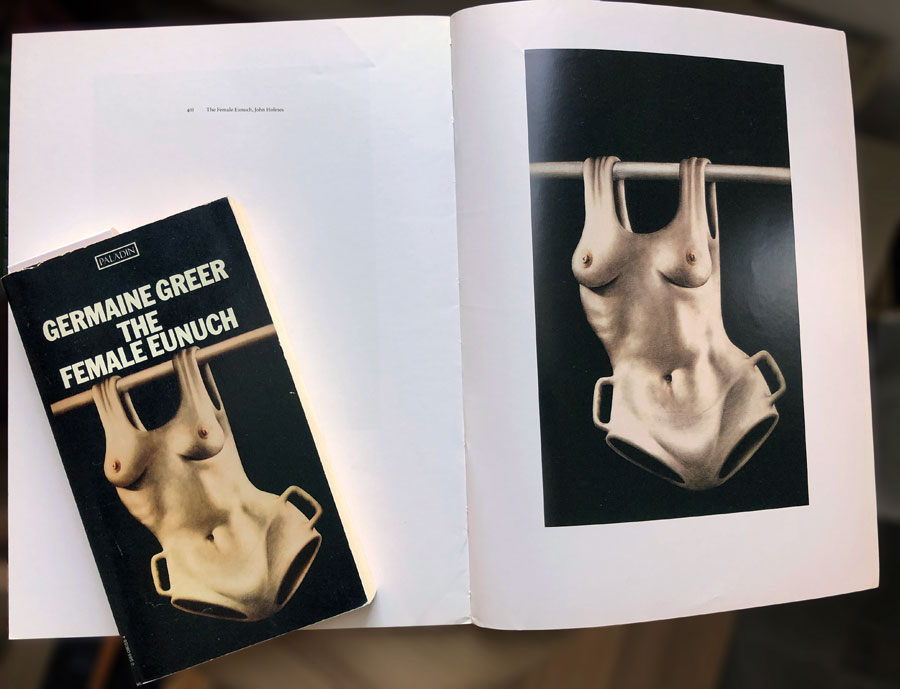
above, John Holmes' The Female Eunuch, c. 1971, used for the cover of Germaine Greer's book of the same name (left), placed on the book Fantastic Art, 1973, (edited by David Larkin, ISBN 345032756495, pl. 40) open on the page with the same image reproduced.
below, David Ho, in his book Shadowmaker, claims he came upon his idea in c. 1998 after looking at "the infinite" amount of womens' clothes.
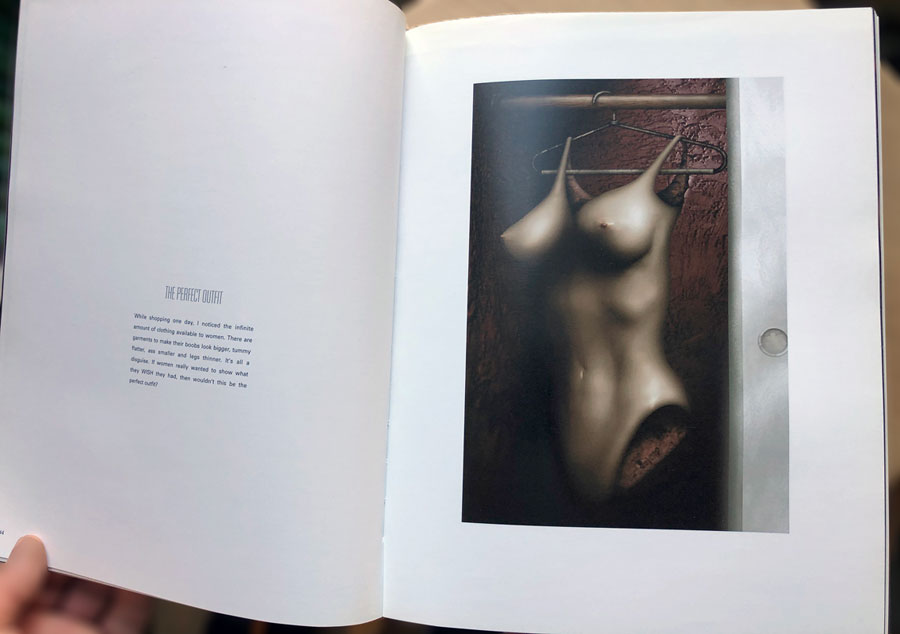
below, the original concept derives from Rene Magritte, Philosophy in the boudoire, 1947, reproduced in the Dictionary of Surrealism, by Jose Pierre, ISBN 0413314308
. 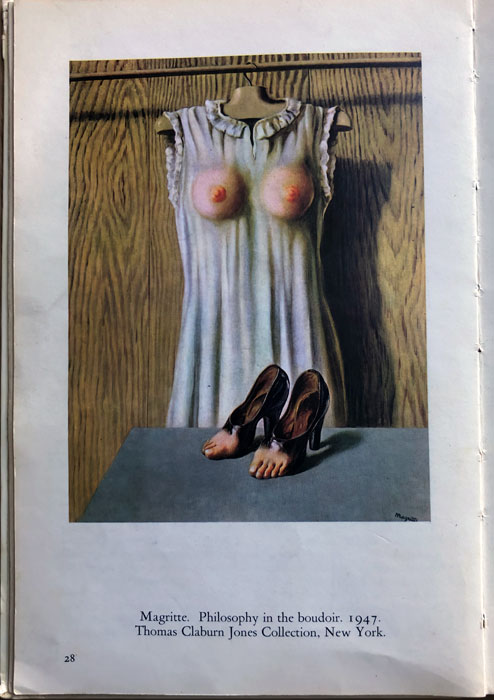
below, letter by Magritte reproduced on p.58, MAGRITTE the true art of painting
ISBN 0500271577, Harry Torczyner, (translated by Richard Miller), 1979, T&H. Magritte writes of spending an evening with psychologists and being questioned by them about his work The Red Model. The psychologists concluded the painting was an expression of a fear of castration.
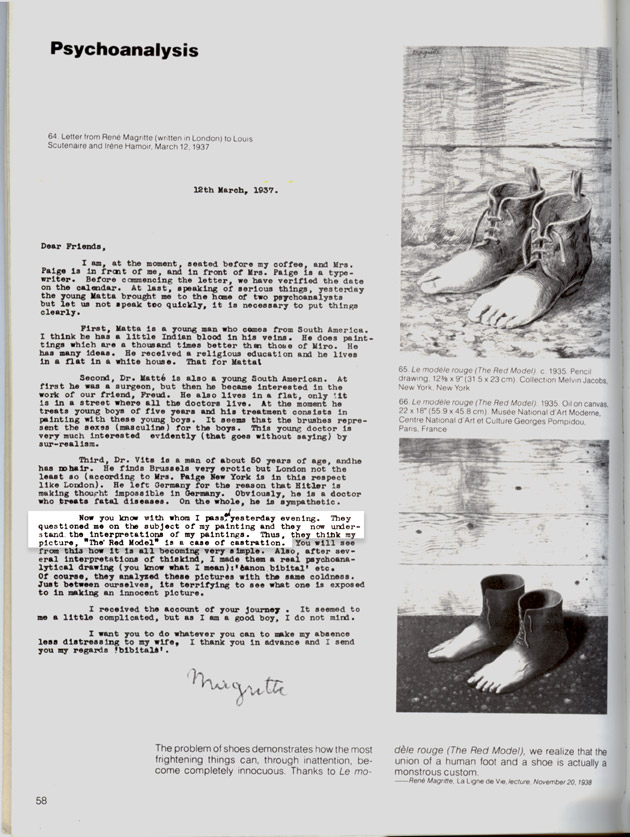
below, the fiction of the "fear of castration" created by the psychoanalytical approach to art analysis knows no apparent limit. Art critic/writer Edward Lucie-Smith wrote in Eroticism in Western Art, ISBN 050020121, T&H 1972, that studies by Gericault for his Raft of the Medusa were really an expression of a fear of castration.
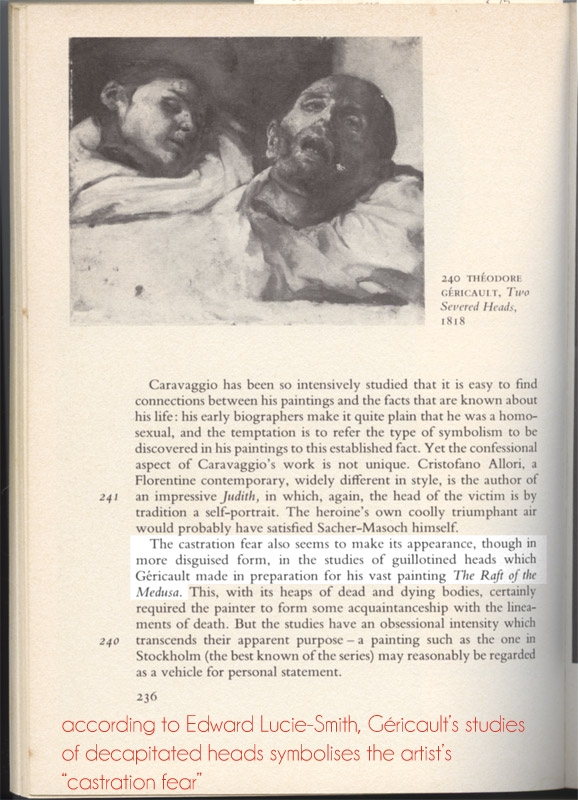
|

